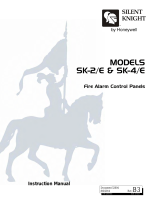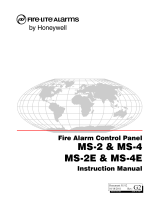Page is loading ...

DN-6619:A3 • 3/19/2015 — Page 1 of 4
411 Series
Slave Digital Alarm
Communicator Transmitters
Miscellaneous
DN-6619:A3 • K-95
General
The 411 Series DACTs are compact, multifaceted, slave Digital
Alarm Communicator Transmitters designed for a variety of
fire, security, and non-fire applications. The series features the
411 and 411UD, which provide three and four monitoring chan-
nels (inputs) respectively. These slave DACTs are a solution
for applications that require an existing (or new) fire alarm con-
trol panel (FACP) to transmit system status to an off-site moni-
toring facility for Central or Remote Station compliance. Due to
extremely flexible programming options, the 411 Series slave
DACTs are also ideal for monitoring non-fire and security con-
trol panels. With fifteen selectable transmission formats
(including ADEMCO Contact ID) compatibility with virtually all
Digital Alarm Communicator Receivers (DACR) is ensured.
Programming can be accomplished on-site with a hand-held
programmer (PRO-411), or remotely (411UD only) using the
PK-411UD programming utility. This Windows®-based remote
upload/download software package permits system interroga-
tion and revision from a remote site.
Features
• Three (411) or four (411UD) monitoring channels (inputs)
• Inputs may be individually programmed to monitor the host
control panel for:
–Fire Alarm
–Fire Trouble
–Fire Supervisory
–Process Monitoring
–AC Power Loss
–Security Alarm
–Other (Fire and Non-Fire Events)
• Trigger inputs require a contact closure for activation
• 12- or 24-VDC operation, jumper-selectable
• Industry-first, UL recognized, “dialer-runaway” prevention
feature
• Dual-line, rotary or touch-tone-dial DACT interfaces to pub-
lic switched telephone network (leased phone lines are not
required)
• Includes 15 reporting formats, including the popular
ADEMCO Contact ID format
• Capable of transmitting the following DACT information, in
addition to vital system status of the host control panel:
–DACT troubles
–Telephone line 1 and 2 voltage fault
–Primary or Secondary Central Station communication
fault
–System off-normal
–24-hour normal test
–24-hour abnormal test
• Long-distance Carrier Access Code (CAC) compliant,
accepting up to 20-digit Central Station telephone numbers
• Fully programmable transmittal codes for fire, security, pro-
cess monitoring, and others
• Field-programmable with PRO-411 hand-held programmer
• Programmable from remote site with optional PK-411UD
programming software (model 411UD only)
• View 411 Series status off-site in real time, with optional
PK-411UD programming software, without ever compromis-
ing monitoring protection at the protected premises (model
411UD only)
• Integral piezo sounder with local silence switch
• One Form-C relay, fully programmable
• Complies with NFPA 72 (Central Station and Remote Sta-
tion [DACT only - not polarity reversal] Fire Alarm Systems)
• Extremely compact enclosure, measuring only 6.841"
(17.376 cm) W x 4.595" (11.671 cm) H x 1.0" (2.54 cm) D
Host Panel Compatibility
Host panels must include AC Fail Delay option to meet NFPA
Central Station Requirements. Panels with this feature include
RP-2001, RP-2002, SFP-2402, SFP-2404, NFS-320, NFS-
640, NFS2-640, NFS-3030, and NFS2-3030.
Housing
The 411 Series DACTs are fully enclosed in a compact hous-
ing measuring only 6.841" (17.376 cm) W x 4.595" (11.671
cm) H x 1.0" (2.54 cm) D. The housing enclosure consists of
an aluminum backbox painted red with a matching cover
secured by two captive screws. The overlay includes large
areas to independently mark programming options for the
three or four channels (inputs), relay, and also includes printed
terminal and diagnostic LED designations.
Phone Line Connections
Two modular phone connections on the 411 Series are acces-
sible with the cover in place and provide connections for two
separate telephone lines using standard RJ31X or RJ38X
jacks. Both telephone lines are constantly supervised for
proper operation and integrity. If one phone line goes into fault
while the other is working, a report is sent to the central or
remote station.
Diagnostic LEDs
• Communication Fail (visible with front cover in place).
firealarmresources.com

Page 2 of 4 — DN-6619:A3 • 3/19/2015
• DACT Trouble (visible with front cover in place) (411UD).
• Channel Active (visible with front cover in place) (411UD).
• Primary Phone Line (PH1) Active (411UD).
• Secondary Phone Line (PH2) Active (411UD).
Specifications
Listings and Approvals:
• NFPA 72: Central Station Fire Alarm Systems.
• NFPA 72: Remote Station Fire Alarm Systems.
• UL Standard 1635: Digital Alarm Communicator/Transmit-
ters.
• UL Standard 864: Control Units for Fire Alarm Systems.
FCC Registration: 1W6AL04B411UDAC. Ringer Equiva-
lence: 0.4 B.
Programming: A digital programming unit with a keypad,
model PRO-411, is available for programming the 411 Series.
Operating Power: The circuit board operates on filtered 12
VDC. The configuration of Jumper J4 determines whether 12
VDC power is to be supplied directly to the circuit board, or 24
VDC power is to be supplied and then internally regulated
down to 12 VDC.
DC Power: TB1 Terminals 4(+) and 5(–); Terminal 6 is Earth
Ground.
• J4 Jumper shorted on pins 2 and 3 - Filtered, non-resetta-
ble and power-limited 24 VDC (nominal) power must be
supplied at TB1 Terminals 4(+) and 5(-). UL-listed operating
range is 17 to 28 VDC. Current requirements are 64 mA in
standby and 120 mA* while communicating.
• J4 Jumper shorted on pins 1 and 2 - Filtered, non-resetta-
ble and power-limited 12 VDC (nominal) power must be
supplied at TB1 Terminals 4(+) and 5(-). UL-listed operating
range is 9.8 to 14 VDC. Current requirements are 88 mA in
standby and 140 mA* while communicating.
*NOTE: A maximum of 200 mA is possible with all input channels
shorted, the 411/411UD communicating, the Programmer con-
nected, and Lamp Test active.
Channels/Inputs:**
• Programmable Channels 1 through 3 (411) or 4 (411UD).
• Power-limited circuitry.
• Operation: All channels NFPA Style B (Class B). Requires
Normally Open contact to trigger.
• Normal operating voltage: 12 VDC.
• Alarm current: 2.68 mA.
• End-of-line resistor: 2.2K ohms, 1/2 watt (P/N 27070).
• Short-circuit current: 3.9 mA per channel/input.
• Restricted to 20 feet (6 m) in conduit and in the same room
**NOTE: Channels/inputs do NOT support two-wire smoke detec-
tors.
Form-C Relay:
• Contact rating: 2.0 amps @ 30 VDC (resistive).
Agency Listings and Approvals
These listings and approvals apply to the modules specified in
this document. In some cases, certain modules or applications
may not be listed by certain approval agencies, or listing may
be in process. Consult factory for latest listing status.
•UL Listed: S2424.
•MEA Listed: 328-94-E Vol. III (411UD); 328-94-E Vol. IV
(411).
•CSFM: 7300-0075:0174.
•FDNY: COA#6085.
Product Line Information
411: Three-channel, dual-line, slave Digital Alarm Communi-
cator Transmitter with Form-C programmable relay and
silence switch. Includes housing, operating and programming
instructions. Requires PRO-411 hand-held DACT programmer
for local programming.
411UD: Same as above with four input channels and remote
upload/download capability. Requires PRO-411 hand-held
DACT programmer for local programming or PK-411UD Win-
dows-based programming software for remote programming
and real-time diagnostics.
PRO-411: Hand-held programmer for local programming of
411 Series DACTs.
PK-411UD: 411UD programming software; available for down-
load at www.esd.notifier.com or ships on PK-CD.
PK-CD: Remote upload/download, Windows®-compatible
programming software kit (for use with 411UD only).
MCBL-7: DACT phone cord, seven feet long (two required).
NOTE: For information about 411UDAC, see DN-60797.
firealarmresources.com

DN-6619:A3 • 3/19/2015 — Page 3 of 4
Compatible UL-Listed Receivers
(1) With version 3.9 software.
(2) With 685-8 Line Card with Rev. 4.4d software.
(3) With 9002 Line Card Rev. 9035 software or 9032 Line Card with 9326A software.
(4) With 124077V2.00 Receiver and 126047 Line Card Rev. M.
(5) With V.7301 Receiver S/W.
(6) With 01.01.03 Receiver S/W and Line Card 01.01.03.
(7) Surgard System III software version 1.6.
(8) Surgard MLR-2 software version 1.86.
(9) With DSP4016 and V1.6 Line Card.
(10) With 124060V206B and 124063 Line Card Rev. B
Format #
(Addresses 20 and 50)
FBI
CP220FB (1)
Ademco
685 (2)
Silent Knight
9000 (3)
Silent Knight
9800 (4)
Osborne Hoffman
2000E (5)
Radionics
6600 (6)
Surgard
System III (7)
Surguard
MLR-2 (8)
Surguard
MR-2000 (9)
Ademco
MX8000 (10)
0 4+1 Ademco Express
1 4+2 Ademco Express
2 3+1/Standard/1800/2300
3 3+1/Expanded/1800/2300
4 3+1/Standard/1900/1400
5 3+1/Expanded/1900/1400
6 4+1/Standard/1800/2300
7 4+1/Expanded/1800/2300
8 4+1/Standard/1900/1400
9 4+1/Expanded/1900/1400
A 4+2/Standard/1800/2300
B 4+2/Expanded/1800/2300
C 4+2/Standard/1900/1400
D 4+2/Expanded/1900/1400
E Ademco Contact ID
firealarmresources.com

Page 4 of 4 — DN-6619:A3 • 3/19/2015
NOTIFIER® is a registered trademark of Honeywell International Inc.
Windows® is a registered trademark of Microsoft Corporation.
©2015 by Honeywell International Inc. All rights reserved. Unauthorized use
of this document is strictly prohibited.
This document is not intended to be used for installation purposes.
We try to keep our product information up-to-date and accurate.
We cannot cover all specific applications or anticipate all requirements.
All specifications are subject to change without notice.
For more information, contact Notifier. Phone: (203) 484-7161, FAX: (203) 484-7118.
www.notifier.com
Assembled in the USA
firealarmresources.com
/



